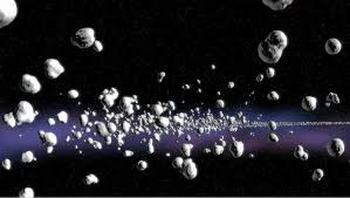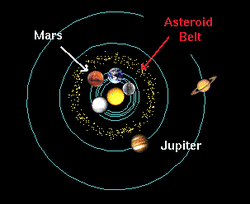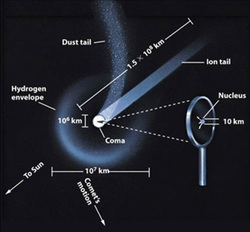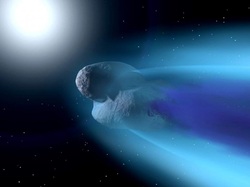Asteroids and Comets
You may think that asteroids and comets are just chunks of space rock floating around with the stars and planets. You may think they are just things you see shooting across the sky, and then what you make wishes on. After reading this, you will have a better understanding of what asteroids and comets really are, and how they relate to physics.
Asteroids

The largest of the minor bodies in the solar system are asteroids. Since they are too small to be considered planets, they are described as minor planets. They are made up of materials left over from the formation of the solar system. The lumps of rock can be from a couple centimeters wide up to 1000 kilometers wide. Most asteroids are in the asteroid belt and orbit the Sun between Mars and Jupiter with a slightly elliptical orbit. Their time for one revolution around the Sun ranges from three to six Earth years. Some others orbit just nearby and are considered Potentially Hazardous Asteroids because they could collide with the Earth, becoming meteoroids. There are even some asteroids that are pulled out of orbit by a planet's gravitational pull and continue to orbit the planet instead of the Sun.
Where's the Physics?

There is absolutely a connection between asteroids in our solar system to physics. One of the main connections is gravity. Asteroids have an elliptical orbit, more of an oval than a circle. The gravitational pull of the asteroid belt between the inner and outer planets force the thousands of asteroids to orbit the Sun. Other asteroids have been taken by a planet's gravitational pull out of orbit and cause them to orbit that planet rather than the Sun. Without the physics of gravity working with the asteroids, there would be no asteroid belt keeping the asteroids in orbit around the Sun, or other space bodies.
Asteroids Game
The player's controls consist of thrust and fire buttons, and rotate left/rotate right buttons (actually rotate counter-clockwise and rotate clockwise respectively). The momentum of the player's ship is not conserved, and it starts to slow down if thrust is not applied. There is also a hyperspace button, which randomly teleports the player's ship somewhere on the screen, with the risk of exploding upon rematerialization (or rematerializing inside an asteroid).
The player's ship spawns in the middle of the screen, with 4 large asteroids drifting around. Each large asteroid (20 points) breaks into 2 medium-sized ones (50 points) when shot, which in turn breaks into 2 small (100 points) asteroids
The player's ship spawns in the middle of the screen, with 4 large asteroids drifting around. Each large asteroid (20 points) breaks into 2 medium-sized ones (50 points) when shot, which in turn breaks into 2 small (100 points) asteroids
Comets

Comets are also small bodies in the solar system. They are a mixture of ices of water and frozen gases, and dust. They have a nucleus (frozen water, gas, and dust), a coma (dense cloud of water, carbon dioxide, and other neutral gases), and a long tail (dust and ionized gases). The tail appears when the comet is near the Sun and can be up to 250 million kilometers long. Like asteroids, comets orbit the Sun. They have a very elliptical orbit. The velocity greatly increases when the comet is near the Sun and the comet begins to vaporize. The tail always points away from the Sun because of the solar wind force. Comets are only visible when they are near the Sun. After around 500 passes near the Sun, the comet loses most of its ice and gas causing the appearance like that of an asteroid. There are also Sungrazers, which are comets that crash into the Sun or get so close that they burn up.
Where's the Physics?

The connection between comets and physics also has to do with gravity. Comets also have an elliptical orbit which moves them towards and away from the Sun. When the comet is near the Sun, it has an increase in velocity, which is also physics-related. We can also find physics as the comet moves towards the Sun by looking at the transformation of the body as it vaporizes. The kinetic thermal energy from the Sun transfers to the comet which vaporizes it, and the vaporized particles form the tail of the comet. Eventually the comet will lose most of its ice and gas.
Other helpful websites
Solar Views- http://www.solarviews.com/eng/index.htm
Enchanted Learning: Astronomy- http://www.enchantedlearning.com/subjects/astronomy/
Enchanted Learning: Astronomy- http://www.enchantedlearning.com/subjects/astronomy/
Works Cited
http://www.gcse.com/eb/oth1.htm
http://www.solarviews.com/eng/asteroid.htm
http://www.enchantedlearning.com/subjects/astronomy/asteroids/
http://www.solarviews.com/eng/comet.htm
http://nineplanets.org/comets.html
http://www.enchantedlearning.com/subjects/astronomy/comet/
https://encrypted.google.com/
http://www.play.vg/games/4-Asteroids.html
http://www.playpacman.net/asteroids/
http://www.solarviews.com/eng/asteroid.htm
http://www.enchantedlearning.com/subjects/astronomy/asteroids/
http://www.solarviews.com/eng/comet.htm
http://nineplanets.org/comets.html
http://www.enchantedlearning.com/subjects/astronomy/comet/
https://encrypted.google.com/
http://www.play.vg/games/4-Asteroids.html
http://www.playpacman.net/asteroids/
